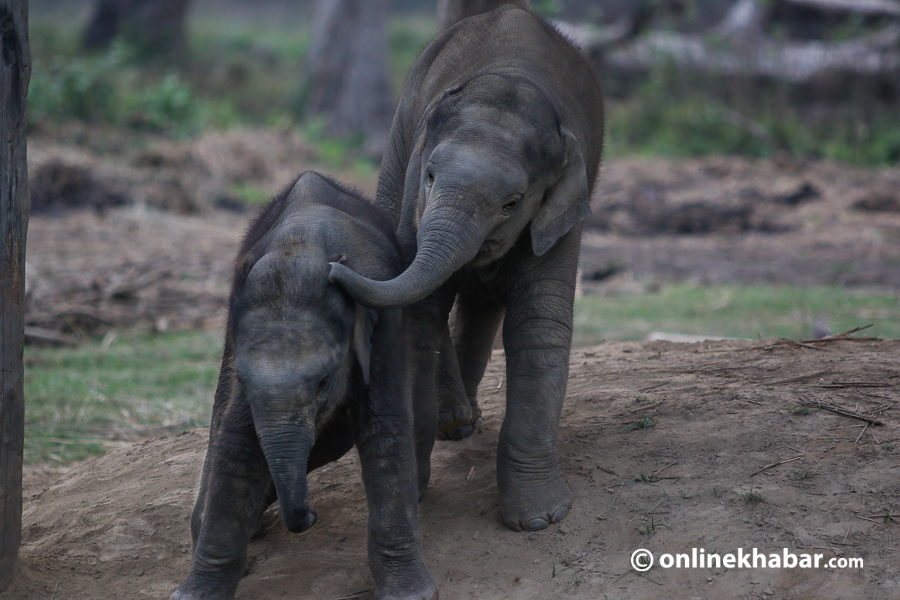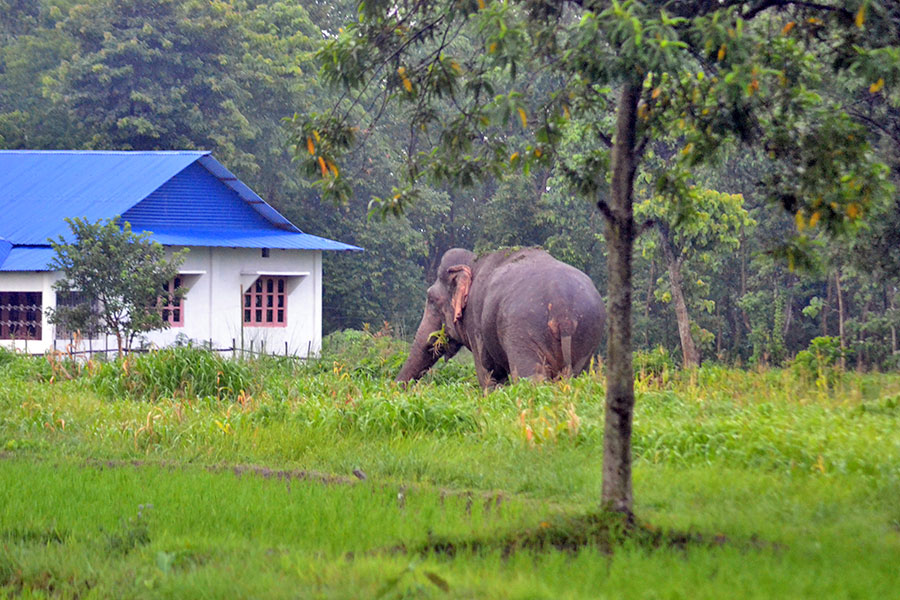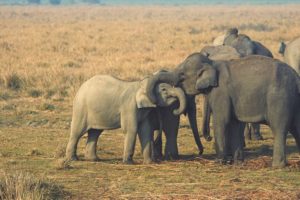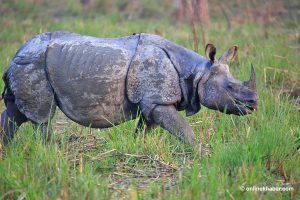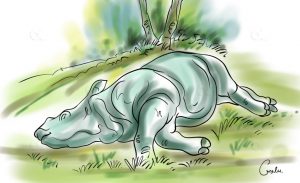Of the 57 elephants in Chitwan National Park, 37 are named after people. Some of them have got the names of the former royal family members whereas others got named after conservationists, ministers, and more recently wildlife bureaucrats.
From monarchs to staff
Likewise, some elephants are named after rivers and famous places, such as Narayani Kali, Karnali Kali, Tamor Kali, Gandaki Kali, Amaltari Gaj, Madi Gaj, Khosar Gaj, Kasara Gaj, etc.
Male elephants, notorious for their attacks, have also got the names of the people who were in the limelight at that time. Traumatised by those wild aggressive elephants, the locals have given them names like Dhurbe, Ronaldo, and Govinde.
The names of six elephants in Chitwan National Park have been matched with the names of members of the former royal family members. These names are Komal Kali, Aishwarya Mala, Dhirendra Kali, Himani Kali, and Prerana Kali. The name of an elephant brought from Koshitappu Wildlife Reserve to Chitwan National Park temporarily is Paras Kali.
Before the People’s Movement 2006, the news of the birth of every calf would reach the royal family and they would name them. Although the Department of National Parks and Wildlife Conservation (DNPWC) was responsible for naming the elephants, due to the palace’s interest in it, the monarch and his family were informed every time a new elephant’s calf would be born.
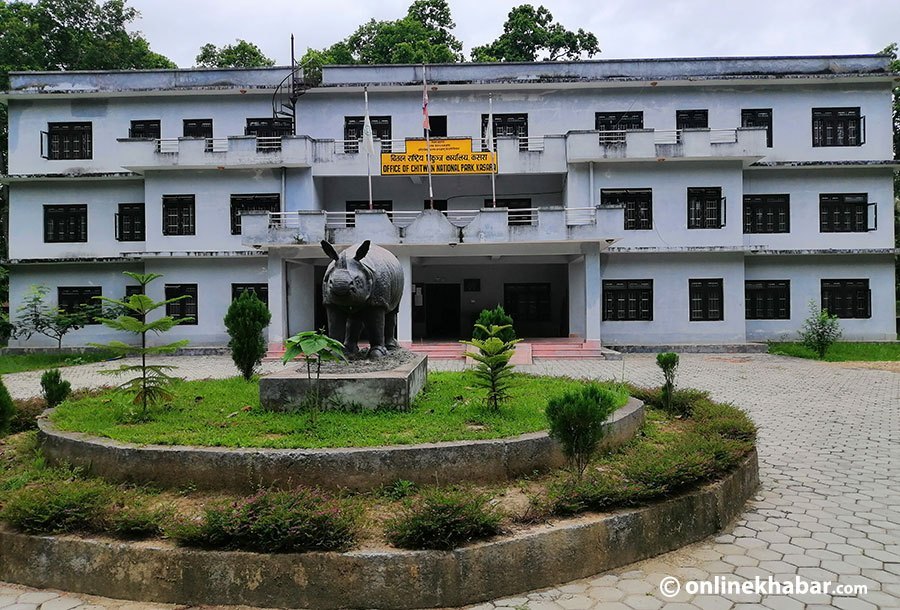
However, after the end of the monarchy, the employees of the national park have started naming elephants as per their will.
There are many elephants in Chitwan National Park with names that match the names of the staff of the Department of Forests and Soil Conservation and the national park.
An elephant is also named after the Secretary at the Ministry of Forests and Environment, Bishwa Nath Oli. As per the staff of the Chitwan National Park, a calf born at the time when Oli (who was the Director-General of the Department of Forests and Soil Conservation then) went to Chitwan, was named as Bishwa Gaj.
There are many such cases. While Krishna Chandra Poudel was the Secretary at the Ministry of Forests and Environment, he also took the opportunity to name an elephant’s calf as Krishnachandra Gaj. Similarly, Gopal Gaj was named after Gopal Prakash Bhattarai, former Director-General of the DNPWC, and Kamal Prasad Gaj was named after a senior veterinary expert of the national park, according to the administration of the Chitwan National Park.
Likewise, Tek Bahadur Thapa, who was the Minister for Agriculture Development and Forest and Soil Conservation in the cabinet headed by the then Chief Justice Khil Raj Regmi, had also named an elephant Tek Gaj.
Chief Warden of Chitwan National Park, Ananath Baral, says as there are no clear criteria for the naming of elephants, the national park gives a name to the elephants.
Further, he adds, “Elephants are usually named after people who have made significant contributions to wildlife conservation.”
A female elephant has been named after Tirthaman Maskey, a famous conservationist who lost his life in a helicopter crash in Taplejung 14 years ago.
Some exceptions
While most of the elephants have been named after the names of either the royal family or the staff of the national park or the ministers or secretaries, some elephants have got their names based on their fate. One of such elephants is Lucky Gaj and here goes the story behind its name.
Ten years ago, an elephant fell ill in the elephant shelter of Chitwan National Park. When its health condition worsened to the state that it could not even eat, it was given saline.
However, its health condition did not improve. Instead, its situation gradually went on deteriorating to the point that it became difficult to know if the elephant was breathing.
Eventually, the park’s veterinary experts went to eat, reporting to the chief warden that the elephant could not be saved. When they returned after eating, the elephant showed an unusual improvement. Excited, the team again gave it saline. And, within three hours, the elephant got up. Therefore, the elephant was named Lucky Gaj.

Implications in terms of good governance
In the report of the Office of the Auditor-General in 2008, weaknesses regarding the naming of elephants have been pointed out. The report reads, “Naming of the elephants seems to have been done by the national parks at their discretion. The acts, rules, and directives related to the national parks do not clearly state the process of registering elephants. Thus, in addition to the lack of uniformity in the record system of such actions done without clear policies and regulations, it cannot be said that it will help in controlling the illegal trade of elephants.”
Hari Bhadra Acharya, the information officer of the DNPWC, also agrees that the names could be misused sometimes for the want of clear criteria. One can name the elephant matching the name of one’s own family or relatives, but it is also a matter of the conscience of the responsible person, according to him.
The naming ritual
Separate records are kept by mentioning the date of birth of the elephant’s calf and its motherr, and appearance. The mother elephant is not left in the pasture for 12 days.
And, on the 12th day, the naming ceremony is performed by calling a priest.
According to Rajendra Panohar, head of the elephants’ shelter of Chitwan National Park, the naming process of elephant’s calf is very similar to that of humans.
“According to the time, date, and nakshatra when a calf touches the ground at birth, a name derived from astrology is used in the government records,” he says, “And, for daily life, a separate name is given to the elephant with love.”



